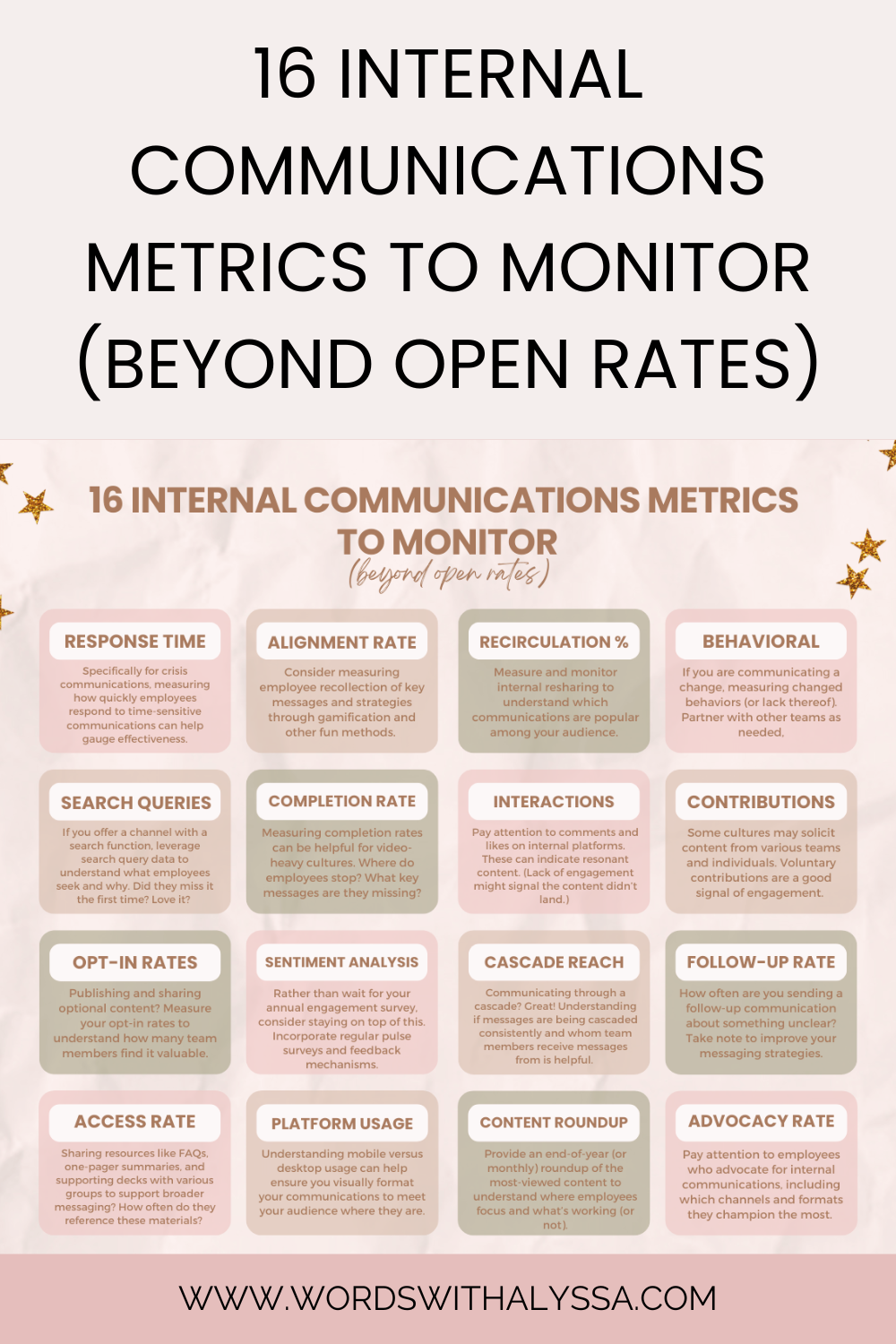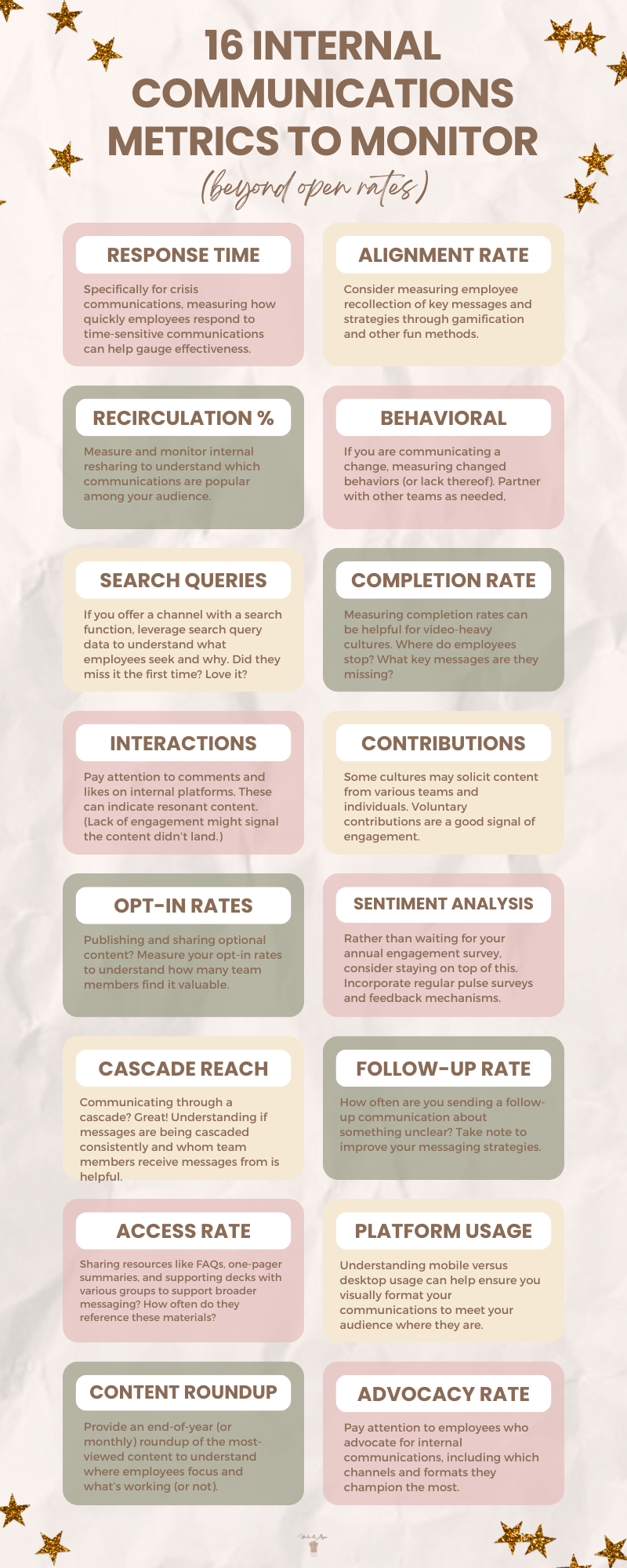
16 Internal Communications Metrics to Monitor (Beyond Open Rates)
PSA: Open and click-through rates are not enough when it comes to measuring the effectiveness and impact of your internal communications. Look, I know how rewarding it feels to see high open and click-through rates, but at the end of the day, these metrics are nothing more than numbers on a page and offer little in the way of measuring communication effectiveness.
Think about the messages you send as an internal communicator. Some common ones might include:
- Informing your team of critical business information
- Sharing the organization's vision and strategy
- Explaining key business decisions that impact people and how they do their jobs
- Connecting employees to a purpose to inspire them to do their best work
Regardless of your message's angle, your goal is to influence behavior in some way.
Why open and click-through rates aren’t always good internal communication metrics
But influencing behavior extends beyond an open or a click. Here's a basic example to put this into context.
Suppose I'm cooking dinner and realize I'm out of three critical ingredients for my pasta. I can't run to the store because I've already started cooking, so I text my husband to explain the situation and ask him to pick up the ingredients for us. In the text, I include a link to our shared grocery list (shoutout to shared Apple notes!).
One hour later, he opens the text. (Yay! My open rate increased!)
He skims the text, clicks the link (Nice—a click!) to the grocery list…and then gets distracted at work.
He's busy with meetings and hot deadlines the rest of the day. By the end of the workday, he forgot about my text message altogether.
The metrics show that he opened and clicked, which, on paper, is a win.
But I didn't influence his behavior to stop by the grocery store and pick up the needed items.
See the problem?
16 internal comms metrics to consider
This happens frequently in internal communications. We review traditional analytics, such as newsletter open rates and click-through rates on all staff email CTAs, and we feel on top of the world because the numbers tell us that we are doing a great job. Then, we discover that we aren’t influencing any behaviors, and our gold star metrics reveal little about our value and progress.
Now, that’s not to say that open and click-through rates aren’t a practical starting point, because they can be. Indeed, if employees aren’t spending time opening emails or clicking on essential links, we can’t influence their behavior. However, I always encourage internal communicators to consider these metrics as the first step in influencing others.
So if you’re ready to dig deeper into your impact and whether your internal communication strategy is working, and want to measure progress over time, here are 16 internal comms metrics worth exploring:
1. Response time
Specifically for crisis communications, measuring how quickly employees respond to time-sensitive communications can help gauge effectiveness.
What do you need your employees to do in this situation? Respond to an email? Click a link in your employee portal? Respond to an SMS?
Whatever the action in crisis is, identify a reasonable measurement that allows you to gauge how quickly (or not) team members respond.
2. Alignment rate
Consider measuring employee recollection of key messages and strategies through gamification and other fun methods.
For example, consider including an individual or team competition at the end of your all-hands meetings, where you quiz your employees on the key messages you shared over the past month through your newsletter, Slack, and all-hands announcements. Make it fun (not forced) and include prizes that people actually want (e.g., money, gift cards, free lunch, high-quality company swag items) to motivate them to participate.
3. Recirculation metrics
If your organization has access to or can obtain access to internal communications and employee engagement tools that offer advanced analytics, consider measuring and monitoring internal resharing to understand which communications are popular among your audience.
If, for example, an intranet article circulates quickly and widely throughout the organization, spend time trying to understand what made it so popular. Was it the content? Was it the format (text, video)? Was it the author (the CEO we never hear from, who is now dropping a major bombshell)?
4. Behavioral response
If you are communicating a change, you should be measuring changed behaviors (or lack thereof). Some examples include:
- Technology or platform changes (shifting from one software program to another)
- Employee actions (e.g., completing benefits enrollment when shifting providers)
- Reporting and org structure changes (e.g., individual reporting manager changes)
When measuring behavioral responses, internal communication professionals will likely need to partner with other teams, such as HR, IT, and dedicated change management, as changes often involve multiple stakeholder groups and access to various tools and resources.
5. Search queries
If you offer communication channels, leverage search query data to understand what employees seek and why.
What terms are they using? Did they miss the message the first time? If so, why? What information did they find most valuable that caused them to revisit the initial announcement?
6. Completion rate
Measuring completion rates can be helpful for video and audio-heavy cultures. Where do employees stop a video? What key messages are they missing by stopping early?
Use completion rate information to restructure your memos to ensure key messages reach the viewer before they pause or stop the video or audio update.
7. Interaction count
Pay attention to comments and likes on internal platforms. These can indicate resonant content. (Lack of engagement might signal the content didn’t land.) Slack, Microsoft Teams, and Discord are excellent platforms for monitoring interactions.
8. Contribution count
Some cultures may solicit content from various teams and individuals. For example, your company newsletter may include updates from departments on a rotational basis. Voluntary contributions are a good signal of engagement.
9. Opt-in rates
Publishing and sharing optional content? Teams often use this method to allow employees to opt in to content and committee information that interests them (e.g., a designated newsletter for an employee resource group or event invitations organized by location). Measure your opt-in rates to understand how many team members find it valuable.
10. Sentiment analysis
Rather than wait for your annual engagement survey, consider staying on top of this. Incorporate regular pulse surveys and employee feedback mechanisms. Even a simple smiley face or star ranking scale is a quick and easy way to stay on top of which communications are landing and which ones are falling short.
11. Cascade reach
Communicating through a cascade? Great! Understanding whether your leaders and managers are consistently cascading messages (using the same verbiage) and which team members receive these messages is helpful. You can use pulse surveys to ask employees from whom they received an update and whether they received key messages from that person.
12. Follow-up rate
How often do you send follow-up communications about something unclear? If you frequently need to send follow-ups because employees express confusion, a lack of engagement, or distrust, consider asking for informal feedback to understand why specific messages are not working. Take note to improve your messaging strategies.
13. Access rate
Sharing resources like FAQs, one-pager summaries, and supporting decks with various groups to support broader messaging? How often do they reference these materials? Can you review how many times an individual opened a document? If someone isn’t opening your reference materials, consider whether the resources themselves could use some improvement, or whether how you share and communicate them isn’t working.
14. Platform usage
Understanding your team’s mobile versus desktop usage can help ensure you visually format your communications to meet your audience where they are. Asking employees directly, as well as tracking access, can help confirm where to spend your time for the best results.
15. Content roundup
Provide an end-of-year (or monthly) roundup of the most-viewed content to understand where employees focus and what’s working (or not). Reshare this content with employees and consider asking (formally or informally) for feedback on what they liked or disliked about each piece of content. Then, use this information to guide future campaigns and plan your internal communications strategy.
16. Advocacy rate
Pay attention to employees who advocate for internal communications, including which channels and formats they champion the most. Consider offering these individuals the opportunity to provide direct feedback on an ongoing basis to inform internal communications experiments.
Effective internal communication is all about influence
Internal communications don’t need to follow traditional metrics and fluffy numbers that can (but often don’t) tell the whole story. Instead, dig deeper and think about internal communications from a psychological perspective, uncovering the roots of effective communications that land.
Need fractional internal comms support to help you boost your metrics and create more impactful comms?
If you need help with a specific topic, fill out this form to leave a content suggestion. I look forward to hearing from you!

0 Comments Add a Comment?